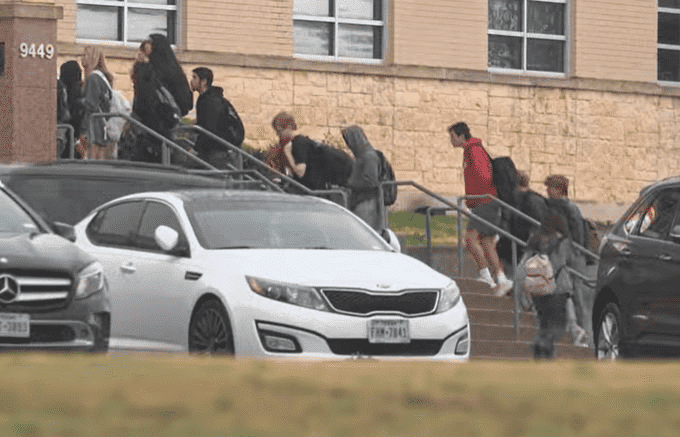As school shooting incidents continue to climb, schools are looking for new ways to strengthen security measures—and a single point of entry is one security protocol that’s gaining momentum.
Most of us have experienced single point of entry at stadiums, event venues, or office buildings, and today, schools are starting to roll out a single point of entry in an attempt to curb gun-related violence. But how effective is this protocol in school environments, and what alternatives are out there?
In this blog, we’ll break down the pros, cons, and alternative solutions that can help you reduce the threat and impact of active shooter incidents.
What is a ‘Single Point of Entry?’
A ‘Single point of entry’ is a security method that is becoming more common in schools. With this approach, school administrators try to limit the entry of students, visitors, and parents to one specific location. In the majority of cases, a single point of entry is designated to screen people for threats like guns, knives, or other weapons.
After the 2018 shooting at Stoneman Douglas High School in Parkland, Florida, the Federal Commission on School Safety recommended that all schools have a “single point of entry” to limit access to the building.
In the aftermath of the school shooting in Uvalde, Texas, earlier this year, this concept garnered renewed interest across the country. In the immediate aftermath, school officials need to show the public they are doing something and a physical change to the building is a visible example of this.
Pros of Single Point of Entry
The goal behind single point of entry is that every single person who enters the building will be screened for threats. If properly employed, no weapons should enter the premises.
Deterrent for Bad Actors
A single point of entry can be a deterrent for bad actors. People who want to bring a gun on campus may be discouraged by the visible security measures. While it’s not foolproof, the mere appearance of high security can greatly reduce the number of potential bad actors.
Can Provide Peace of Mind
In some environments, a single point of entry can help bring peace of mind. For example, people attending an event may find reassurance that bags are being checked for weapons before entering the venue. And while some argue that single point of entry can be a disturbance in schools, some parents feel better knowing there are strict protocols at their childrens’ school.
Enables Visitor Management
Every organization’s visitor management process looks different, but for many, a single point of entry or gated entrance is one of the first steps in the management process. During this initial checkpoint, staff will screen whether this visitor is someone who should have access and provide next steps such as sign-in forms or guest badges. While a tight process like this may eat up more resources than most schools have, this can be especially useful for workplaces with high security protocols.
Cons of Single Point of Entry
Like most things in life, school security isn’t that simple. Having people enter, and often exit, through one entrance creates a whole new set of problems that can be even worse.
Long lines create new security risks
Having a single door instead of dozens of doors instantly causes a traffic jam. The same situation happens at stadiums and arenas right before game time. The difference with schools is that increased security is intended to protect the students and creating crowds of students who don’t have anywhere to “run, hide, or fight” is a new vulnerability.
115 shootings at schools have happened when the school first opens before morning classes start, including a planned attack in Marshall County, Kentucky, mere weeks before Parkland in 2018. The teenage student attacker knew the hallways would be packed with students before morning classes when he opened fire and shot 20 classmates. Even if the school had a metal detector and single point of entry, the students would have been shot before the shooter was screened.
Misguided efforts to keep students safe inside the school can have the opposite effect as students become vulnerable standing outside of the building.

At first glance you might think teens are lining up for Taylor Swift tickets, but this is just another morning at schools across the country that have added metal detectors or body scanners at a ‘single point of entry.’ Photo source
Fences, locked doors, and perimeter patrols are far from failsafe
A single entry point screening can be easily bypassed by going in another door, window, or throwing a bag over the fence then getting after going through security. To keep people from bypassing a security checkpoint, you also need fences, locked doors, and guards patrolling the perimeter to make sure doors aren’t propped open or someone doesn’t climb over a fence.
Even the secure perimeter is far from failsafe. Fences serve as a deterrent to keep intruders out but they can easily be scaled, vehicles can drive through them, and students can pass weapons or contraband items through or over them.
Screening has limitations
Security screening isn’t just a first thing in the morning operation. Just like the airport, anyone who leaves the building needs to be screened again. Students coming back into the building from gym class, lunch, field trips, doctor’s appointments, and off campus activities all need to be screened. A student could have tossed a gun over the fence into bushes and picked it up during gym class. If they don’t go back through the metal detectors, now there is a gun inside the building.
Poor student experience and morale
Another consideration leaders have to think through is how the security affects morale. Does creating a single point of entry negatively impact the school’s environment?
In some cases, parents and students may feel safer knowing that someone is screening people for weapons. In other cases, students struggle with feeling like they are entering a prison yard instead of a school yard. Additionally, getting screened each morning can feel invasive to some students.
Why Have Metal Detectors at Only One Door?
Just like the TSA checkpoint at the airport, it’s a complicated operation to comprehensively screen thousands of people and bags coming to a building.
- Each metal detector needs to be staffed by someone who is trained to use it
- Another staff member is needed to search the bag
- There needs to be a third person ready to assist if a weapon is found
- A fourth person needs to be watching to make sure nobody is bypassing the detectors.
Just like the airport, if a detector goes off and the metal activating it is not readily apparent, there need to be two pairs of secondary screeners of each gender that can take a student to a private area. Eight different staff members are required for every single metal detector!
Screening equipment isn’t a one-time purchase — it requires ongoing maintenance and staff need recurring training to ensure they’re using it correctly. The labor cost of running a single metal detector is high, which is why it’s not realistic for schools to add metal detectors to all entrances.

Lines stretched to the parking lot of Lake Highlands High (TX) as students waited to go through metal detectors added in early March after a student was shot in an apartment complex across from the school.
Alternative Solution: Proactive Visual AI Gun Detection & Situational Awareness Platform
Keeping students safe is not an easy task—and what works for some schools may not work for others. The one thing that we can say with certainty is that situational awareness and early detection can only ever make a bad situation better—they can never make it worse or make students more vulnerable.
Visual AI Gun Detection 101
ZeroEyes’ Visual AI (artificial intelligence) gun detection technology is used across schools nationwide. Here’s a quick breakdown of how it works:
- Leverage Existing Security Cameras: ZeroEyes’ Visual AI Gun Detection software is installed on existing digital security cameras on school grounds.
- 24/7/365 Security Coverage: AI-enabled cameras analyze for visible, illegally-brandished guns 24/7/365.
- Human Verification: Gun detections are immediately audited by an in-house, U.S.-based, highly-trained analyst.
- Situational Awareness: Human-verified gun detection alerts are dispatched in as fast as 3-5 seconds to authorized personnel and local law enforcement, along with key data points like the shooter’s image and geolocation.
Scenario #1: ZeroEyes Layered With Single Point of Entry
Any effective security system should have multiple layers in place. If Single Point of Entry works for your organization, implementing a Visual Gun Detection and Situational Awareness platform can help resolve potential vulnerabilities found in Single Point of Entry.
For example:
- If a gun is tossed over a fence and picked up by a student, the system will detect this and notify authorized personnel of this threat.
- If an attacker with a gun is walking towards a group of students outside, this will be spotted within seconds, and authorities will receive real-time updates of the shooter’s most recent location.
- When a fight escalates into a shooting and the shooter runs away, school staff and police will know precisely where the threat is.
Scenario #2: Single Point of Entry Isn’t For You, But Proactive Threat Detection Is
Unlike metal detectors or scanners at a single entry point, digital security camera systems equipped with visual gun detection software can spot a gun anywhere on the campus.This is helpful in school environments that often have multiple doors open throughout the day.
Since the software is integrated onto existing security cameras, it also aacts as an “invisible” layer of security that does not negatively impact the student experience or school morale.
Watch the testimonial below to see why Dot Blackwell of Vassar Public Schools chose ZeroEyes’ proactive solution when it was time to reassess and upgrade school security.
If you’re interested in implementing ZeroEyes at your school, reach out to us for a live demo.

